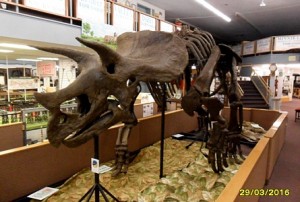 Valley City (CSi) The Barnes County Historical Society in Valley City is the new happy home for a Triceratops from the North Dakota Geological Survey!
Valley City (CSi) The Barnes County Historical Society in Valley City is the new happy home for a Triceratops from the North Dakota Geological Survey!Gundy the Triceratops
Mike Triebold, of Triebold Paleontology, discovered Gundy in 1992 on private ranch-land in the Hell Creek formation deposits of Northwestern South Dakota. She was more than 80% complete. Her skull is 5 1/2 feet long and 4 feet wide and was almost 95% complete in its fossil form. She is about 18 feet long.
Gundy is a sub-adult Triceratops prorsus. There are two main types: T. prorsus, which has a double-curve to the brow horns and a large nose horn, and T. horridus, which has straighter brow horns and a small nose horn. T. prorsus is usually found higher in the strata than T. horridus, so there is the possibility that T. prorsus evolved from T. horridus. The original specimen is on display at the Gunma Prefectural Museum in Japan.
· The name ‘Triceratops’ comes from the Greek language, with ‘tri’ meaning three, ‘kéras’ meaning horn, and ‘ops’ meaning face.
· Triceratops lived in the late Cretaceous Period (around 66 million years ago).
· The Triceratops is one of the most easily recognizable dinosaurs due to its large body, unique frill and three horns.
· It needed its three horns to try and protect itself from the Tyrannosaurus rex which lived during the same time period, as well as identify other members of its species.
· It is believed that fully grown Triceratops were about 26ft long, 10ft high and weighed anywhere from 6 to 12 tons.
· The skull of a Triceratops alone could grow over 7ft in length.
· Triceratops was the most common dinosaur species found in the Hell Creek Formation of North Dakota.
· The Triceratops was a plant eating (herbivore) dinosaur












Comments are closed
Sorry, but you cannot leave a comment for this post.